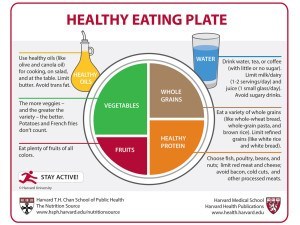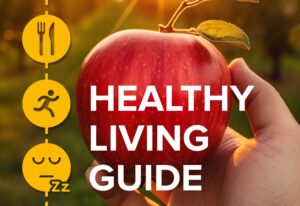Healthy Eating Plate
Drink water, tea, or coffee (with little or no sugar). Limit milk/dairy (1-2 servings/day) and juice (1 small glass/day). Avoid sugary drinks.
The more veggies — and the greater the variety — the better. Potatoes and French fries don’t count.
Eat plenty of fruits of all colors
Choose fish, poultry, beans, and nuts; limit red meat and cheese; avoid bacon, cold cuts, and other processed meats.
Eat a variety of whole grains (like whole-wheat bread, whole-grain pasta, and brown rice). Limit refined grains (like white rice and white bread).
Incorporate physical activity into your daily routine.
Looking for a printable copy? Download one here, and hang it on your refrigerator to serve as a daily reminder when planning and preparing your meals! Translations of the Healthy Eating Plate are also available in over 25 languages.
Building a Healthy and Balanced Diet
Make most of your meal vegetables and fruits – ½ of your plate.
Aim for color and variety, and remember that potatoes don’t count as vegetables on the Healthy Eating Plate because of their negative impact on blood sugar.
Go for whole grains – ¼ of your plate.
Whole and intact grains—whole wheat, barley, wheat berries, quinoa, oats, brown rice, and foods made with them, such as whole wheat pasta—have a milder effect on blood sugar and insulin than white bread, white rice, and other refined grains.
Protein power – ¼ of your plate.
Fish, poultry, beans, and nuts are all healthy, versatile protein sources—they can be mixed into salads, and pair well with vegetables on a plate. Limit red meat, and avoid processed meats such as bacon and sausage.
Healthy plant oils – in moderation.
Choose healthy vegetable oils like olive, canola, soy, corn, sunflower, peanut, and others, and avoid partially hydrogenated oils, which contain unhealthy trans fats. Remember that low-fat does not mean “healthy.”
Drink water, coffee, or tea.
Skip sugary drinks, limit milk and dairy products to one to two servings per day, and limit juice to a small glass per day.
Stay active.
The red figure running across the Healthy Eating Plate’s placemat is a reminder that staying active is also important in weight control.
The main message of the Healthy Eating Plate is to focus on diet quality:
- The type of carbohydrate in the diet is more important than the amount of carbohydrate in the diet, because some sources of carbohydrate—like vegetables (other than potatoes), fruits, whole grains, and beans—are healthier than others.
- The Healthy Eating Plate also advises consumers to avoid sugary beverages, a major source of calories—usually with little nutritional value—in the American diet.
- The Healthy Eating Plate encourages consumers to use healthy oils, and it does not set a maximum on the percentage of calories people should get each day from healthy sources of fat. In this way, the Healthy Eating Plate recommends the opposite of the low-fat message promoted for decades by the USDA.

Your Plate and the Planet
Just as different foods can have differing impacts on human health, they also have differing impacts on the environment. Food production is a major contributor to greenhouse gas emissions, and it places an enormous demand upon our earth’s natural resources.
Your Questions Answered
Are the relative sizes of the Healthy Eating Plate sections based on calories or volume?
The Healthy Eating Plate does not define a certain number of calories or servings per day from each food group. The relative section sizes suggest approximate relative proportions of each of the food groups to include on a healthy plate. They are not based on specific calorie amounts, and they are not meant to prescribe a certain number of calories or servings per day, since individuals’ calorie and nutrient needs vary based on age, gender, body size, and level of activity.
How can I apply this guide if I don’t eat my meals from a single plate?
As the name suggests, the Healthy Eating Plate is visualized as a single plate, however it can be used as a guide for creating healthy, balanced meals—no matter which type of dishware is used!
- For example, while you wouldn’t consume soup on a plate—you can consider the relative sizes of each section when choosing what to add to the pot before serving in a bowl: make about half of your ingredients a variety of colorful vegetables (carrots, celery, spinach, tomatoes, sautéed in olive oil), and the other half a mix of whole grains (such as farro) and a healthy protein (such as beans).
- Or maybe you’re eating your meal in courses, or as multiple dishes in smaller sizes: a plate of grilled fish over brown rice; a green side salad filled with veggies; and some fruit for a sweet end to the meal.
- Portioning a meal into separate components is also common when packing a lunchbox—especially for kids.
There are many cultures around the world in which people may not eat their meals from a plate. Although our translations of this guide maintain the single-plate graphic, we encourage its use for creating healthy, balanced meals in context of cultural and individual customs and preferences.
What about alcohol? Isn’t alcohol supposed to be good for you in small amounts?
For some people, moderate alcohol consumption can offer health benefits, whereas for others alcohol may pose risks. Learn more about the risks and benefits of alcohol.
Who created the Healthy Eating Plate?
The Healthy Eating Plate, created by nutrition experts at the Harvard T.H. Chan School of Public Health and editors at Harvard Health Publications, was designed to address deficiencies in the U.S. Department of Agriculture (USDA)’s MyPlate. The Healthy Eating Plate provides detailed guidance, in a simple format, to help people make the best eating choices.
The Healthy Eating Plate is based exclusively on the best available science and was not subjected to political or commercial pressures from food industry lobbyists. Learn more about how the Healthy Eating Plate compares to the USDA’s MyPlate.
What about the Healthy Eating Pyramid? Will it be going away?
Generations of Americans are accustomed to the food pyramid design, and it’s not going away. In fact, the Healthy Eating Pyramid and the Healthy Eating Plate complement each other. See how you can use the Healthy Eating Pyramid as a guide for your grocery shopping list.
Will following the Healthy Eating Pyramid and Healthy Eating Plate guidelines really make me healthier?
According to research done at Harvard Chan School of Public Health and elsewhere [1-3], following the guidelines presented through the Healthy Eating Pyramid and Healthy Eating Plate can lead to a lower risk of heart disease and premature death:
- In the 1990s, the USDA’s Center for Nutrition Policy and Promotion created the Healthy Eating Index “to measure how well American diets conform to recommended healthy eating patterns.” [4] A score of 100 meant following the federal recommendations to the letter while a score of 0 meant totally ignoring them.
- To see how well the principles embodied in the Healthy Eating Pyramid stacked up against the government’s advice, researchers at the Harvard Chan School of Public Health created an Alternate Healthy Eating Index with a scoring system similar to the USDA’s index. They then compared the two indexes, using information about daily diets collected from more than 100,000 female nurses and male health professionals taking part in two long-term studies.
- The eleven components assessed by the Alternate Healthy Eating Index were dairy products; vegetables; fruit; nuts & seeds; bread/grains; meat, poultry & fish; cholesterol; fat; sodium; alcohol; and multivitamins.
- Men who scored highest on the USDA’s original Healthy Eating Index (meaning their diets most closely followed federal recommendations) reduced their overall risk of developing heart disease, cancer, or other chronic disease by 11% over 8 to 12 years of follow-up compared to those who scored lowest. Women who most closely followed the government’s recommendations were only 3% less likely to have developed a chronic disease. [5]
- In comparison, scores on the Alternate Healthy Eating Index did appear to correlate more closely with better health in both sexes. Men with high scores (those whose diets most closely followed the Healthy Eating Pyramid guidelines) were 20% less likely to have developed a major chronic disease than those with low scores. Women with high scores lowered their overall risk by 11%. Men whose diets most closely followed the Healthy Eating Pyramid lowered their risk of cardiovascular disease by almost 40%; women with high scores lowered their risk by almost 30%.
- In a 2014 study looking at trends in diet quality among adults in the U.S., researchers using the Alternate Healthy Eating Index found that there was steady improvement from 1999 to 2010, but that overall dietary quality remains poor. [6]
Two studies offer further evidence of the disease prevention benefits that accrue from following a diet similar to one based on the Healthy Eating Pyramid:
- A study that tracked 7,319 British civil servants for 18 years found that men and women with the highest scores on the Alternate Healthy Eating Index had a 25% lower risk of dying from any cause, and a 42% lower risk of dying from heart disease, than people with the lowest scores. [3]
- Another observational study in 93,676 post-menopausal women found that following a Healthy Eating Pyramid-style diet (as measured by adherence to the Alternative Healthy Eating Index) was superior to following a low-fat diet at lowering cardiovascular disease and heart failure risk. [1]
Permissions for Use

The Healthy Eating Plate image is owned by Harvard University. The downloadable version may be used, without permission, for educational and other non-commercial uses with proper attribution, including the following copyright notification and credit line:
Copyright © 2011, Harvard University. For more information about The Healthy Eating Plate, please see The Nutrition Source, Department of Nutrition, Harvard T.H. Chan School of Public Health, www.thenutritionsource.org, and Harvard Health Publications, www.health.harvard.edu.
Any other use, including commercial reuse or mounting on other systems, requires permission from the Department of Nutrition at the Harvard T.H. Chan School of Public Health. Please contact us to submit your request.
- Akbaraly TN, Ferrie JE, Berr C, Brunner EJ, Head J, Marmot MG, Singh-Manoux A, Ritchie K, Shipley MJ, Kivimaki M. Alternative Healthy Eating Index and mortality over 18 y of follow-up: results from the Whitehall II cohort. The American journal of clinical nutrition. 2011 May 25;94(1):247-53.
- Belin RJ, Greenland P, Allison M, Martin L, Shikany JM, Larson J, Tinker L, Howard BV, Lloyd-Jones D, Van Horn L. Diet quality and the risk of cardiovascular disease: the Women’s Health Initiative (WHI). The American journal of clinical nutrition. 2011 May 25;94(1):49-57.
- McCullough ML, Feskanich D, Stampfer MJ, Giovannucci EL, Rimm EB, Hu FB, Spiegelman D, Hunter DJ, Colditz GA, Willett WC. Diet quality and major chronic disease risk in men and women: moving toward improved dietary guidance. The American journal of clinical nutrition. 2002 Dec 1;76(6):1261-71.
- U.S. Department of Agriculture, Center for Nutrition Policy and Promotion. The Healthy Eating Index.
- Continuous Update Project Report Summary. Food, Nutrition, Physical Activity, and the Prevention of Colorectal Cancer, 2011.
- Wang DD, Leung CW, Li Y, Ding EL, Chiuve SE, Hu FB, Willett WC. Trends in dietary quality among adults in the United States, 1999 through 2010. JAMA internal medicine. 2014 Oct 1;174(10):1587-95.
Last reviewed January 2023
Terms of Use
The contents of this website are for educational purposes and are not intended to offer personal medical advice. You should seek the advice of your physician or other qualified health provider with any questions you may have regarding a medical condition. Never disregard professional medical advice or delay in seeking it because of something you have read on this website. The Nutrition Source does not recommend or endorse any products.
Support The Nutrition Source
Thank you for supporting our mission of translating food and nutrition knowledge into daily practice!
Make a gift
A monthly update filled with nutrition news and tips from Harvard experts—all designed to help you eat healthier. Sign up here.

Explore the downloadable guide with tips and strategies for healthy eating and healthy living.
Healthy Eating Plate Translations
- طبق الأكل الصحي (Arabic)
- Osasungarri Jateko Platera (Basque)
- Tanjir Zdrave Ishrane (Bosnian)
- El Plat Saludable (Catalan)
- 健康饮食餐盘 (Chinese – Simplified)
- 健康飲食餐盤 (Chinese – Traditional)
- Tanjur Zdrave Prehrane (Croatian)
- Den Sunde Tallerken (Danish)
- Gezonde Voeding Bord (Dutch)
- Healthy Eating Plate (English)
- بشقاب غذای سالم (Farsi)
- L’Assiette Santé (French – Canada)
- Der Gesunde Teller (German)
- Πιάτο Υγιεινής Διατροφής (Greek)
- Plat Manje ki Bon pou Lasante (Haitian Creole)
- Ingantaccan Tsarin Abinci (Hausa)
- स्वस्थ भोजन की थाली (Hindi)
- Efere Iri Ihe Na-Enye Ahụike (Igbo)
- Il Piatto del Mangiar Sano (Italian)
- 健康的な食事プレート (Japanese)
- 한 끼 건강식 (Korean)
- Pinggan Makan Sihat (Malay)
- ЭРҮҮЛ ХООЛЛОХ ТАВАГ (Mongolian)
- Talerz Zdrowego Odżywiania (Polish)
- Prato: Alimentação Saudável (Portuguese)
- Tарелка Здорового Питания (Russian)
- Tanjir Zdrave Ishrane (Serbian)
- El Plato para Comer Saludable (Spanish)
- El Plato para Comer Saludable (Spanish – Spain)
- Sahani ya Mlo Unaofaa (Swahili)
- En Hälsosam Mattallrik (Swedish)
- Sağlıklı Yemek Tabağı (Turkish)
- Dĩa Thức Ăn Bổ Dưỡng (Vietnamese)
- Àwo Oúnjẹ Ìlera (Yoruba)




